| dc.description.abstract | The study of the effects of interactive media has mainly focused on dysregulated behaviors, the conceptualization of which is supported by the paradigms of addiction. Research into Game Transfer Phenomena (GTP) examines the interplay between video game features, events while playing, and the manipulation of hardware, which can lead to sensory-perceptual and cognitive intrusions (e.g., hallucinations and recurrent thoughts) and self-agency transient changes (e.g., automatic behaviors) related to video games. GTP can influence the interpretation of stimuli and everyday interactions and, in contrast to gaming disorder, are relatively common and not necessarily negative. However, some players have reported feeling distress due to their GTP. This study focuses on how dispositional and interactive media habit factors are related to GTP and two forms of problematic interactive media [problematic video game playing (PVG) and problematic social media use (PSMU)]. A sample of 343 university students who played video games completed an online survey (58.7% male, 19–25 years old). Not all who had experienced GTP were identified as exhibiting PVG or PSMU, but all of those in the PVG group had experienced GTP. Overall, the profiles of the groups, including GTP (91.4%), PVG (28.5%), and PSMU (24.8%), were in accordance with previous findings. Those in the GTP and the PVG groups were characterized by being male, being highly engaged in the game (either while playing or via game-related activities), and showed preferences for game-related activities. However, while those in the GTP group were significantly more likely to be fantasy-prone, those with PVG were the ones who played most per day. Those in the PSMU group were characterized by being female and/or extroverted, frequently using social/sharing platforms, and seldom playing video games. A hierarchical binary logistic regression revealed that males were more likely to experience GTP. Increases in PVG, fantasy proneness, and neuroticism increased the odds of GTP. Future work can benefit from considering the role of GTP in gaming disorder, since intrusive thoughts, cognitive biases, and poor impulse control are pivotal in the initiation and maintenance of dysfunctional playing behaviors. | en_US |

